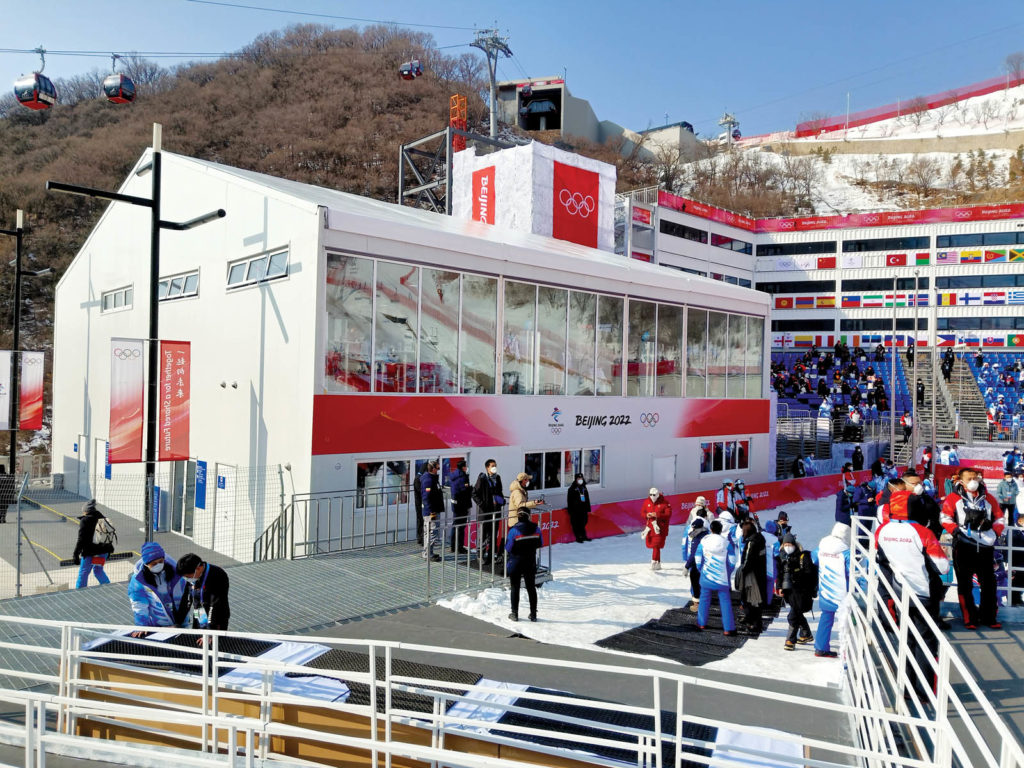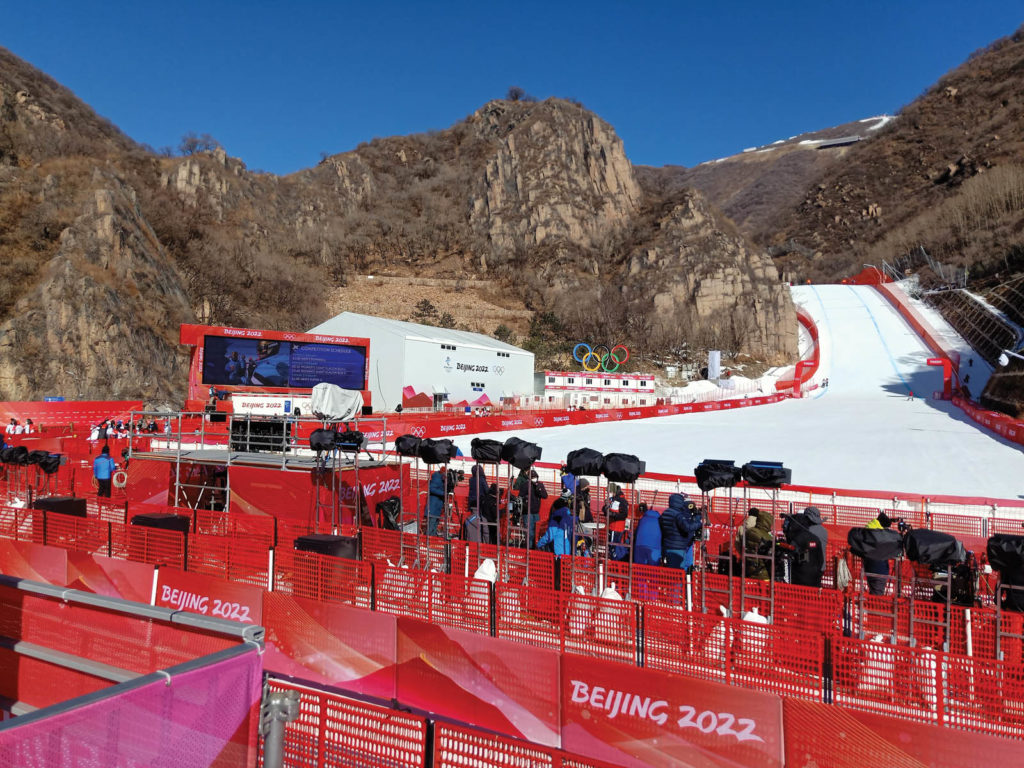
It would have been a tall order for a less adept company. After all, the job wasn’t only extremely high-profile—the Beijing Winter Olympics—it involved providing and setting up more than 30 structures under extreme conditions and on some less-than-ideal terrain, all while adhering to strict COVID protocols. But as one of the largest installers in Asia, Liri Modular Structure in Zhuhai City, Guangdong Province, China, was more than up to the task.
Liri Modular is the operating division of Liri Architecture Technology Co. Ltd. A parent company to Liri Modular, Liri Architecture is engaged in the design, manufacture, sales and rental of aluminum PVC clearspan tent structure systems, explains Lee Tian, managing director. (Liri Modular makes the tents to be installed in China and broader Asia. Liri Tent US has a supply agreement with that company to exclusively sell its products in the U.S.)
“We focus on meeting all kinds of temporary space demand for sports, large exhibitions, festivals, disaster relief, events, warehousing and glamping tents,” says Tian. “We have rich experience in providing structures for international sports events, such as the 16th Asian Games, Shenzhen 26th Summer Universiade, IAAF World Championships Beijing, the 2015 Baku European Games and so on.”
The company was first approached about providing structures for the 24th Winter Olympic games in August 2021. Ultimately, a total area of 10,000 square meters (or about 110,00 square feet) of structures was supplied and installed over various sites. Among these were a Double Decker 20-by-27.5-meter used as a media tent and having a capacity of up to 400 people; a 20-by-18-meter news conference hall accommodating about 300 people; and a 15-by-30-meter lounge that could hold 200. Additional tents were used for a variety of purposes such as security, check-in, food service, equipment storage, souvenir shop, cafeteria, volunteer lounge, restrooms, entry tents, snowmobile maintenance garages and parking garages, just to name a few.

Challenges & solutions
The conditions were extreme and the challenges many.
“The mountain competition venue, located in Yanqing, Beijing, experiences cold winds and large temperature differences between day and night, with temperatures as low as -20 degrees Celsius [-4 degrees Fahrenheit],” says Tian. “In such low-temperature conditions, there are stringent requirements for tent insulation, snow-load resistance, wind resistance and other functions.”
Installation was demanding, encountering “many difficulties,” such as transporting all of the tents and equipment over mountain roads, site fluctuations/uneven ground, limited space and low-temperature construction. In some cases, trucks were unable to directly access a site, requiring that heavy materials be hand-carried instead.
Fifty installers were involved. All were from China and all underwent daily COVID testing. Everyone was required to submit a negative test before being allowed to enter a site. Anyone testing positive would have been sent to a specific hospital for quarantine, says Tian. However, the staff were fortunate not to have anyone test positive during the project.
To meet the insulation, snow-load and wind-resistance requirements, Tian says crew members modified the frame, roof cover system, walling and flooring systems. For example, they added more reinforcing purlins to the structure’s frame. The roof was made in three layers—a 75-mm insulation layer placed between a double-layer PVC fabric roof cover—which not only protected against the extreme cold but also provided sound insulation and energy savings. Flooring was constructed in four layers—two layers of plywood board plus 75-mm insulation glass wool plus loop-pile carpet—and the walling system consisted of customized 10-cm thick steel sandwich panels. Numerous windows were set inside the structures to provide illumination and ventilation. The structures also met infrastructure needs for water, heating and fresh-air systems, HVAC, communication, fire safety, barrier-free access and other conditions.
“To solve the ground fluctuation and to stop dust, rain and snow from getting into the structures, we built a special scaffolding system,” says Tian. “The height of the scaffolding system can be adjusted, so we can adjust the legs to suit uneven ground. The structures were set up on the scaffolding, which is above the ground, so we could say the structures are not set up directly on the ground, but rather on the scaffold system.
“Also, when a structure was set up between two permanent buildings, there is limited space,” he continues. “To address this, we changed our installation method and lifted the frames, using cranes to move them to the site location.”

Lessons learned
Tian says Liri Modular was given two months from the implementation of the contract to prepare for and begin the installations, which took about two months. The structures remained up until March 14 and were also used for the Paralympic Games. As of this writing, the team was in Beijing, awaiting the notice to take down the tents, which he anticipates will take around a month.
“The newest feedback from the Beijing organizing committee of the Olympic Games is that they will keep part of the tents to purchase,” says Tian. “We are waiting for their list of which tents they would like to keep.”
As for how this project benefited the company, Tian says he and his staff improved their insulating solutions—roof system, walling panels, flooring—particularly for structures going up in extreme cold environments.
“Also, we can offer better one-stop service for future projects, not only in the lighting system and AC units but also central ventilation systems, heating systems, fire extinguishing systems, etc.,” he adds. “We gained experience in installing under limited space and cold weather. All of this will help us improve our products and management on-site.”
Pamela Mills-Senn is a freelance writer based in Seal Beach, Calif.
Project highlights
Liri Modular Structure, Zhuhai City, Guangdong Province, China
Beijing Winter Olympics, Yanqing, Beijing, China
110,00 square feet of structures:
20-by-27.5-meter media tent
20-by-18-meter news conference hall
15-by-30-meter lounge
50 installers
 TEXTILES.ORG
TEXTILES.ORG


